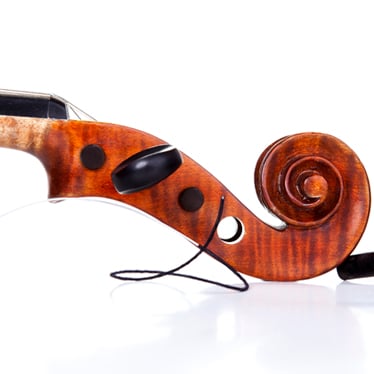Why Do Violin Strings Break?

As a violinist, you’re guaranteed to experience a time when your instrument’s strings snap or break. We’ve posted, What To Do If a String Snaps While Performing to help you prepare for the event.
Strings shouldn’t snap very often. If they do, it’s a sign that something’s wrong. In most cases, a trip to the music store or your favorite luthier is worth the visit because experts can chat with you about the experience (when did it happen, what happened right before, where along the instrument body) did it break, etc., and figure out the best solution.
In the meantime, here are the most common reasons (and locations on your violin) that strings break.
They’re ready for replacement
To start, violin strings are only designed to last for about three to six months, or roughly 300-playing hours. If your strings have survived that span – and then some – a snap is the sign it’s time to replace them.
If you’ve purchased a used violin (or are renting an instrument), we recommend installing new strings pronto to avoid string breaks altogether, unless a reputable violin dealer says the strings are new. If you’re a newer or intermediate player, consider purchasing a medium-gauge synthetic string, like Thomastik-Infeld’s Alphayue line, which yields beautiful tones and is known for its durability.
Exposure to temperature & humidity fluctuations
Proper violin care begins with the right case, a high-quality humidity control accessory (like Boveda’s) and proper storage locations. Constant fluctuations of hot-to-cold, humid-to-dry, and then back again causes brittle strings that are more prone to breaking.
Improper tuning, tightening or winding
We all start somewhere, and new(er) violin students are more apt to experience string snapping when tuning, over-tuning, over-tightening and/or winding their strings incorrectly. Paying careful attention to instructions, taking your time, and basic repetitions of these processes will minimize the number of times strings break on you.
The following articles were written for that cause:
- 3 Steps to Tuning Your Violin
- How to Tighten Loose Violin Strings
- What is the Proper Way to String and Instrument?
When in doubt, always hold off and wait until a teacher, music store employee or luthier can help.
There’s something wrong with the violin’s body
Violin strings are tough enough to withstand the rigor of your fingers, the tension between the pegs and the tailpiece, and your bowing. They are not designed to withstand certain issues with your violin anatomy. Paying attention to where they snapped along the violin’s body is a clue as to why they broke.
Down by the bridge
Are the notches in your bridge or top nut too narrow? If strings can’t rest comfortably in these notches, there’s added abrasion and tension.
Closer to the tailpiece
If the tailpiece slot is too narrow, the string can’t pull all the way through properly and the ball winds up in the wrong position – snap!
Up by the peg box
Improper winding (covered above) is a potential here, especially if strings overlap one another (doubled up) and get pinched at the bottom of the box. Also, if strings aren’t positioned correctly, they can become pinched against the side of the peg box.
Strings aren’t the only victims in this case. If left too long, both of these scenarios can also do damage to the peg and/or the peg box.
At the (top)nut
The perfect violin nut is precisely and gently curved – not too curvy and not too flat. If the nut is too flat, or so curved that it forces the angle of the string, it stresses the string and eventually causes a break.
At the fine tuners (the E string’s enemy)
Improper tuning could be the cause (see above) or it could be there’s a metal burr or a sharp edge causing the problem. Since most E strings are looped, they’re especially vulnerable to sharp-edged fine tuners. If strings tend to snap at the fine tuners, the edges may need to be rounded by a violin maker.
The playing area
Finally, strings break down as the result of finger/hand sweat, oil, and salts. Rosin build-up and bowing also decompose the metal windings (or gut materials) in a violin string. If your strings tend to fray or break around the playing area, you may have logged more playing hours than you thought, Or it could be a sign you need to take greater care of your instrument and its strings.
If you’re meticulous about instrument car and changing the strings as directed, fraying and breakage in the playing area could indicate an anatomical defect of/on the fingerboard.
Regardless of the cause, repeat fraying, snapping or breaking of violin strings is a red flag. Take your violin to the nearest string instrument expert to have the problem assessed by a professional.
Sponsored by Thomastik-Infeld


